I am performing iterative computations to examine how y varies over x in R. My goal is to estimate the x-intercept. Now each iteration is computationally expensive so the fewer iterations needed to achieve this the better.
Here is an image of y plotted against x
 I have created a working example by defining an asymptotic function which adequately captures the problem
I have created a working example by defining an asymptotic function which adequately captures the problem
y <- (-1/x)+0.05
which when plotted yields
x <- 1:100
y <- (-1/x)+0.05
DT <- data.frame(cbind(x=x,y=y))
ggplot(DT, aes(x, y)) + geom_point() + geom_hline(yintercept=0, color="red")
I have developed TWO iterative algorithms to approximate the x-intercept.
Solution 1 : x is initially very small is stepped 1...n times. The size of the steps is pre-defined start large (10-fold increases). After each step y.i is computed. If abs(y.i) < y[i-1] then that large step is repeated, unless y.i changes sign, which indicates that step overshot the x-intercept. If the algorithm overshoots then we backtrack and a smaller step is taken (2-fold increases). With each overshoot, smaller and smaller steps are taken going from 10*,2*,1.1*,1.05*,1.01*,1.005*,1.001*.
x.i <- x <- runif(1,0.0001,0.001)
y.i <- y <- (-1/x.i)+0.05
i <- 2
while(abs(y.i)>0.0001){
x.i <- x[i-1]*10
y.i <- (-1/x.i)+0.05
if(abs(y.i)<abs(y[i-1]) & sign(y.i)==sign(y[i-1])){
x <- c(x,x.i); y <- c(y,y.i)
} else {
x.i <- x[i-1]*2
y.i <- (-1/x.i)+0.05
if(abs(y.i)<abs(y[i-1]) & sign(y.i)==sign(y[i-1])){
x <- c(x,x.i); y <- c(y,y.i)
} else {
x.i <- x[i-1]*1.1
y.i <- (-1/x.i)+0.05
if(abs(y.i)<abs(y[i-1]) & sign(y.i)==sign(y[i-1])){
x <- c(x,x.i); y <- c(y,y.i)
} else {
x.i <- x[i-1]*1.05
y.i <- (-1/x.i)+0.05
if(abs(y.i)<abs(y[i-1]) & sign(y.i)==sign(y[i-1])){
x <- c(x,x.i); y <- c(y,y.i)
} else {
x.i <- x[i-1]*1.01
y.i <- (-1/x.i)+0.05
if(abs(y.i)<abs(y[i-1]) & sign(y.i)==sign(y[i-1])){
x <- c(x,x.i); y <- c(y,y.i)
} else {
x.i <- x[i-1]*1.005
y.i <- (-1/x.i)+0.05
if(abs(y.i)<abs(y[i-1]) & sign(y.i)==sign(y[i-1])){
x <- c(x,x.i); y <- c(y,y.i)
} else {
x.i <- x[i-1]*1.001
y.i <- (-1/x.i)+0.05
}
}
}
}
}
}
i <- i+1
}
Solution 2 : This algorithm is based on ideas from Newton-Raphson method, where steps are based on the rate of change in y. The greater the change the smaller the steps taken.
x.i <- x <- runif(1,0.0001,0.001)
y.i <- y <- (-1/x.i)+0.05
i <- 2
d.i <- d <- NULL
while(abs(y.i)>0.0001){
if(is.null(d.i)){
x.i <- x[i-1]*10
y.i <- (-1/x.i)+0.05
d.i <- (y.i-y[i-1])/(x.i-x[i-1])
x <- c(x,x.i); y <- c(y,y.i); d <- c(d,d.i)
} else {
x.i <- x.i-(y.i/d.i)
y.i <- (-1/x.i)+0.05
d.i <- (y.i-y[i-1])/(x.i-x[i-1])
x <- c(x,x.i); y <- c(y,y.i); d <- c(d,d.i)
}
i <- i+1
}
Comparison
- Solution 1 requires consistently fewer iterations as Solution 2 (1/2 as many if not 1/3).
- Solution 2 is more elegant, does not require arbitrary step size decreases.
- I can envision several scenarios where Solution 1 gets stuck (e.g. if even at the smallest step, the loop does not converge on a small enough value for
y.i)
Questions
- Is there a better (lower number of iterations) way approximate the x-intercept in such scenarios?
- Can anyone point me to some literature that addresses such problems (preferably written comprehensibly to a beginner such as myself)?
- Any suggestions on nomenclature or key words that represent this class of problem/algorithm are welcome.
- Can the solutions i have presented be improved upon?
- Any suggestions on how to make the title/question more accessible to wider community or experts with potential solutions are welcome.
